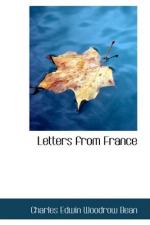That night, shortly after dark, there broke out the most fearful bombardment I have ever seen. As one walked towards the battlefield, the weirdly shattered woods and battered houses stood out almost all the time against one continuous band of flickering light along the eastern skyline. Most of it was far away to the east of our part of the battlefield—in some French or British sector on the far right. There must have been fierce fire upon Pozieres, too, for the Germans were replying to it, hailing the roads with shrapnel and trying to fill the hollows with gas shell. They must have suspected an attack upon this part of their line as well, and were trying to hamper the reserves from moving into position.
About midnight our field artillery lashed down its shrapnel upon the German front line in the open before the village. A few minutes later this fire lifted and the Australian attack was launched.
The Germans had opened in one part with a machine-gun before that final burst of shrapnel, and they opened again immediately after. But there would have been no possibility of stopping that charge with a fire twenty times as heavy. The difficulty was not to get the men forward, but to hold them. With a complicated night attack to be carried through it was necessary to keep the men well in hand.
The first trench was a wretchedly shallow affair in places. Most of the Germans in it were dead—some of them had been lying there for days. The artillery in the meantime had lifted on to the German trenches farther back. Later they lifted to a farther position yet. The Australian infantry dashed at once from the first position captured, across the intervening space over the tramway and into the trees.
It was here that the first real difficulty arose along parts of the line. Some sections found in front of them the trench which they were looking for—an excellent deep trench which had survived the bombardment. Other sections found no recognisable trench at all, but a maze of shell craters and tumbled rubbish, or a simple ditch reduced to white powder. Parties went on through the trees into the village, searching for the position, and pushed so close to the fringe of their own shell fire that some were wounded by it. However, where they found no trench they started to dig one as best they could. Shortly after the bombardment shifted a little farther, and a third attack came through and swept, in most parts, right up to the position which the troops had been ordered to take up.
As daylight gradually spread over that bleached surface Australians could occasionally be seen walking about in the trees and through the part of the village they had been ordered to take. The position was being rapidly “consolidated.” German snipers in the north-east of the village and across the main road could see them, too. A patrol was sent across the main road to find a sniper. It bombed some dug-outs which it found there, and from one of them




